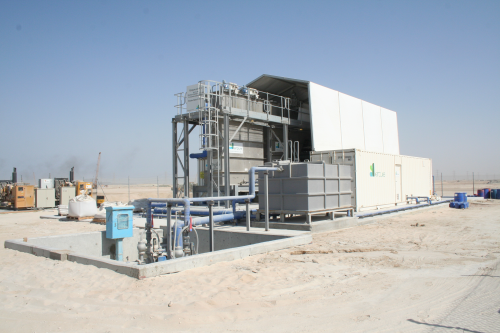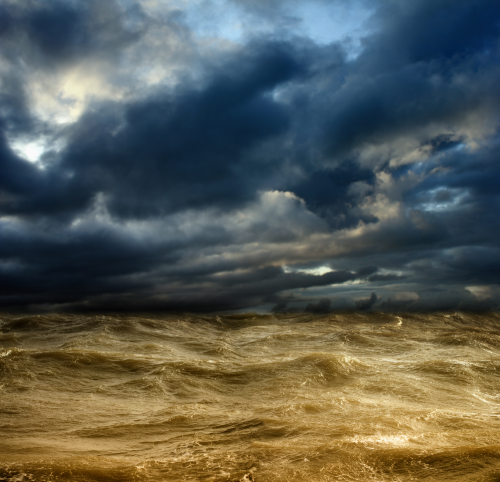

Chemical pre-treatment
Coagulation has been one of the most popular pre-treatment processes for the removal of potential foulants such as colloidal and particulate matter since the onset of desalination by reverse osmosis in the 1960s. Coagulation combines small particulates into larger flocs by neutralising the electrostatic charges associated with the particles, a process termed flocculation. Inorganic coagulants are typically used in SWRO systems, such as ferric chloride, and these can be combined with organic flocculants, such as polyelectrolyte, for dosing in-line ahead of downstream clarification and filtration processes. In addition to particulate fouling, SWRO membranes are susceptible to scaling and salt precipitation. This is because they typically operate at up to 50% system recovery on seawater applications and hence the concentration of salts can be twice the incoming level in the reject stream from the RO membranes. Scale control can be achieved by dosing acid (to reduce the pH) and various proprietary antiscalant chemicals targeted at certain supersaturated ions, such as boron. Pre-oxidation is also employed in an attempt to reduce RO biofouling by targeting NOM, such as humic and fulvic acids, but this can have a detrimental effect on membranes that are intolerant to oxidation, and some microorganisms and microbiota are resistant to oxidation. Also, chlorination can cause cell lysis and hence release of substrate which encourages growth. Pre-oxidation chemicals used include chlorine, bromide, iodine or ozone. UV irradiation can also be used along with biofiltration to remove nutrients, and proprietary biocides can be added as a continuous dose or as part of the membrane cleaning regime. Various combinations of pre-oxidation methods can be employed such as UV in conjunction with ozone. Electro-chlorination is used to produce oxidative chlorine from seawater using an electric current although this can be cost prohibitive in some locations.
Conventional pre-treatment
The traditional conventional methods of treating seawater intended for processing via SWRO have included sedimentation (following in-line coagulation), media filtration and cartridge filtration. Filtration tends to include single or double stages of dual media filtration (DMF). Whilst this filtration technology has generally been able to cope with lower suspended solids levels and other contaminants, they have found it increasingly more difficult to cater for the more buoyant and fragile nature of algae. In addition, there is the need to increase the level of coagulant dosing at times of algae blooms ultimately resulting in an increased solids load onto the filters and invariably shorter filter run times or more frequent backwashing, all factors increasing operational costs. One established technology that is recognised as able to efficiently remove the algae load, and hence reduce the solids load onto downstream processes, but also minimise coagulant chemical requirements, is dissolved air flotation (DAF). DAF essentially works by the release of previously dissolved air and dosing coagulants into the feed supply to produce a treated subnatant and a concentrated waste ‘sludge’ that is captured and floats to the surface of the DAF unit. By varying the hydraulic loading on the DAF unit, along with optimising air concentration, coagulant concentration and the sludge removal rate and mechanism, the best DAF efficiency can be determined. As algae are intrinsically light and of low density, the material is naturally suited to flotation using DAF rather than settlement processes. The application of DAF in the wider water industry for both municipal potable supply and industrial processing is well established and it has been demonstrated that this technology is reliable and robust. DAF units can be supplied by a number of contractors including Enpure Ltd. Enpure’s packages, such as the Enflo-DAF™ products, minimise the flocculation residence time requirements at typically 10 minutes or less and to date operate at a high-rate, up to 30 m/h in SWRO pre-treatment applications, thereby reducing the footprint required for the overall plant. Other types of conventional pre-filtration include adsorption and multi-media filtration (MMF). Absorption is typically achieved by using granular activated carbon for the reduction of NOM either as a filter media or by being dosed and recirculated through a contact system. MMF systems are typically pressurised filters that operate at a higher velocity but tend to treat lower flows than the larger gravity fed DMF processes.
Case study - Ras Al Khair project
Enpure is currently working on the Ras Al Khair Project in Saudi Arabia, a GBP16.3 million DAF/DMF SWRO pre-treatment plant for the Doosan Heavy Industries and Construction Company Ltd at a Saline Water Conversion Corporation site (see Figure 3). The DAF plant is sized to treat 41,922 m3/h, and the DMF treats 39,654 m3/h. Enpure was contracted to design the system, supply key equipment and supervise installation, with commissioning scheduled for completion in May 2013. An integral component of the project philosophy was the supply and operation of an integrated pilot testing phase. Ras Al Khair is located on the Eastern seaboard of Saudi Arabia and the raw seawater conditions are generally typical of those found in the northern end of the Arabian Gulf. A pilot plant was designed to treat seawater with total dissolved solids (TDS) ranging from 38,000 mg/l to 47,000 mg/l and total suspended solids (TSS) ranging from 20 mg/l to 40 mg/l. The fully automated full scale DAF system comprises 16 streams of Enpure’s high-rate EnFlo-ViteTM process, incorporating a recently developed distribution system, static mixers, nozzles, headers, air saturators, recycle pumps, dosing pumps, instrumentation, valves and penstocks. The treated filtrate from the DAF system passes forward via gravity flow to 40 DMF streams comprising filter media, filter floors, blowers, backwash pumps, instrumentation and valves. The DAF and DMF stages are required to treat the seawater to meet strict criteria (post DMF) prior to pumping to the SWRO process stage. These are turbidity <0.5 NTU and SDI (silt density index, after a 15 minute test) <4 at the DMF common filtrate. The DAF pilot plant comprised a single EnFlo-Vite™ stream, treating 61.2 m3/h followed by four DMF units each treating 2.5 m3/h. The pilot plant has completed over 9 months of continuous operation. Enpure say that the results to date demonstrate that the process is operating well within the specified performance limits; with the DMF achieving the required SWRO feed water specification. The pilot plant included ancillary pumps, chemical dosing systems, control panels (inclusive of programmable logic control (with human interface) to provide automatic operation) and a fully equipped laboratory, all built into two, fully air-conditioned container units.
Membrane pre-treatment
With the exception of DAF, whilst conventional processes have been widely used for SWRO pre-treatment, the need for careful design and close operator control has resulted in the increasing popularity of using ultrafiltration (UF), microfiltration (MF) and also, to a lesser extent, nanofiltration (NF) systems for SWRO pre-treatment. Various manufacturers of MF/UF technology will guarantee SDI < 2 (providing specified inlet parameters are not exceeded) and extensive pilot testing has been undertaken over recent decades. UF membranes probably give the process design engineer the best balance between contaminant removal and RO feed quality but, as we have stated, any unit process selection would be dependent on site specific conditions. It is important to note that UF systems may require their own pre-treatment in certain conditions and these could include the processes already described. DAF technology can be combined with UF and could, in the example of algae removal, provide an alternative to either single or two stage DMF. Coagulation can be used up front of UF systems with the potential to improve SWRO feed quality further. The best option can be to use an automated system to utilise a low coagulant dose during periods of poor feed quality, typically at a third or less of the concentration required by conventional pre-treatment. This concentration can then be reduced, potentially to zero, when feed quality is good. As described in a previous article on cost effective desalination (Filtration+Separation July/August 2011), the established way of exploiting osmosis is to operate the process in reverse (reverse osmosis) by applying pressure to the saltwater side of the membrane to overcome the osmotic pressure and drive water from the saline to the freshwater side of the membrane. However, direct (as opposed to reverse) osmosis processes offer a different novel approach through the potential for harnessing energy by exploiting the osmotic principle. Systems which are designed to treat filtered water as a pre-treatment technology directly prior to SWRO system are called Forward Osmosis (FO) systems. A draw solution is used in the FO process to create a driving force for freshwater to pass through the FO membrane. This draw solution is more concentrated than the seawater and is a solution of an osmotic agent, typically ammonium bicarbonate. The FO membrane is supplied with saline water and the permeate passes through into the draw solution by direct osmosis due to the difference in concentration. The solutes in the draw solution are then recovered and reused and the purified draw solution forms the treated water for downstream processing in the SWRO system.
Conclusions
Different pre-treatment technologies will often preferentially remove certain contaminants and will have different effects on SWRO membrane fouling. Hence, the role of the process design engineer in selecting the appropriate unit processes is critical to ensure an efficient and optimised system. Highly variable feed water with contaminants such as algae, which have been traditionally difficult to treat, presents considerable challenges. Only by using experiences gained on other sites and projecting this onto an effective pilot testing programme can an effective system be developed. It may then also be important to note that the chosen process design may not operate efficiently under certain conditions or with changing climate or weather conditions affecting local seawater composition and temperature (see Figure 4). Hence, ongoing monitoring and optimisation of the desalination system is required to ensure any changes are detected early. By effectively and efficiently combining various pre-treatment processes, such as the popularity of UF membranes, the suitability of DAF for solving algae problems and the implementation of FO to reduce power requirements, it will be possible to increase the overall reliability of SWRO systems whilst continuing to drive down whole life costs. More sophisticated process control and operational monitoring will also enable systems to be adapted in response to the challenges of climate change.
